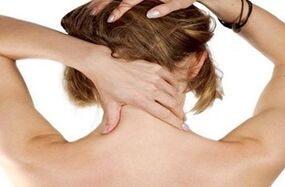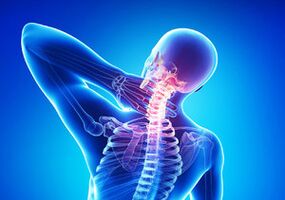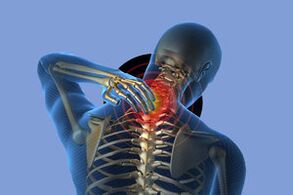
Today, a disease such as osteochondrosis is very common, and many people have a feeling of fear and great concern.
As medical practice has shown, the appearance of the disease is facilitated by several main causes, which, as a rule, are directly provoked by patients.
To avoid this disease and prevent its appearance, you need to know the inherent basic symptoms and causes.
The causes of osteochondrosis of the cervical vertebrae
Most often, osteochondrosis of the cervical vertebrae is manifested in the form of degenerative-dystrophic lesion of the intervertebral disc.As practice shows, the disease appears and develops against the background of disorders of metabolic processes that occur in the area of the cervical region.In this case, there is a significant change in the structure and structure of individual vertebrae and intervertebral discs.
The passage of the disease in osteochondrosis of the cervical vertebrae is slightly different from osteochondrosis, which affects other parts (we are talking about lumbar and breast form of osteochondrosis).This type of disease is more dangerous, as it contributes to the infringement of the spine directly, which moves away from the brain of the spinal nerve and, thus, disrupts the blood supply to the vessels of the brain due to direct infringement and squeezing of blood vessels.
In addition, the structure of the vertebrae (in this case, more densely located among themselves) in the cervical region is slightly different from others, therefore, when any change in the pathology appears in one of them, a noticeable violation of the normal work of the entire spine.That is why with cervical osteochondrosis of the patient, such obvious features as: frequent dizziness, impaired muscles and skin of the hands, neck, face, constant headaches, unpleasant ringing and ears or noise in the head, worsening of hearing or vision, increased feeling of fatigue, shaky and insecure gait, loss of coordination, and so on.
So, you need to pay great attention to the fact that osteochondrosis of the cervical vertebrae appears as a result:

- raising heavy objects and cargo;
- work that is directly related to a constant change in the position of the body - we are talking about extension, bending, circular movements, turns;
- active sports and physical education;
- improper posture during bedridden, sedentary, standing positions of the body, as well as during the lifting and transfer of weights;
- genetic disposition;
- adverse weather conditions.
The main symptoms of cervical osteochondrosis
Often, symptoms of osteochondrosis in the first stages of its manifestations can not show themselves in any way.Already moving to a more neglected stage, the disease begins to manifest itself with frequent cramping pain sensations in any movements of the head and neck.However, the symptoms of osteochondrosis are quite diverse and explained by degenerative changes and disorders in the structure of the cartilage, or the result of severe pinching, a displaced disk of the vertebral artery, which passes between disks.
Pain
The most important and most first symptoms of osteochondrosis of the cervical vertebrae are pain that can be quickly passing at the first stage, and then acquire a chronic shape.The pain can appear in the area of the occipital muscles, shoulders and neck and become stronger when turning or tilting the head and neck.Given the place in which the lesion is located, the pain can have aching and constant in nature.And it can temporarily subside or be shooting and sharp.Moreover, any movements of the head and neck are difficult in time, which is associated with constant muscle tension in the neck.
When squeezing the artery of the spine with cartilaginous tissue, an intervertebral disc or tense muscles, a person can torment the cervical migraine (headache that appears as a result of oxygen starvation of tissues and weakening of blood circulation), a severe leap in the increase, short -term loss and impaired consciousness, the appearance of ears, and the appearance of “flies” before the eyes of “flies”.Headache is sometimes accompanied by vomiting or nausea.
Nausea
Osteochondrosis of the cervical vertebrae can be accompanied by nausea.Moreover, nausea is associated with circulatory disorders in the vessels of the brain.Quite often, a person’s appetite disappears, as a result of this there is a lack of nutrients in the body, and the overall weight decreases.In more severe cases, the disease is accompanied by vomiting, which appears during tilts of the head, turns, and even just when walking.As mentioned above, this occurs due to a violation of the process of blood flow and insufficient oxygen intake to the inner ear, where the equilibrium center is located.
Air lack

Symptoms of cervical osteochondrosis include such a sign as an air lack.It appears with a direct lesion of the cervical area and is expressed in irritation of the diaphragmatic nerve.As a result, it becomes difficult for a person to breathe, the patient lacks air, there is a lack of oxygen, shortness of breath begins, and a strong suffocation may even occur.
As a rule, the lack of air is accompanied by snoring, especially during an uncomfortable position of the head during rest.This condition leads to the fact that a person wakes up very tired and completely broken, he is concerned about the general malaise and weakness.A long stay in this state leads to a decrease in concentration of attention, a deterioration in memory and irreversible changes in brain tissue.
Ringing and noise in the ears
Signs of cervical osteochondrosis are sometimes manifested in the form of ringing and noise in the ears.Just the vestibular apparatus is enriched with blood exclusively from the system of vertebrates.That is why, with inflammation of the cervical region, a violation of the function of the inner ear occurs, as a result, a person is tormented by ringing and noise in the ears.Sometimes a hearing deterioration is added to the described symptoms.
Glooping signs
Osteochondrosis of the cervical vertebrae can manifest itself in this way.Often a person is worried about an unpleasant and constant feeling of dryness and sore throat, difficulty swallowing, tickling and itching, a feeling of a foreign body.All these symptoms are directly associated with impaired vascular and nerve trunks that go from the spinal cord.
Vision of vision
The most common and frequent sign of cervical osteochondrosis is the deterioration of visual acuity.This is due to the fact that the visual analyzer is enriched with blood not only thanks to sleepy, but also due to the vertebral arteries.During compression of these arteries, visual impairment occurs.
Moreover, patients can complain about:
- low pressure;
- atherosclerosis of the arteries of the brain;
- violation of focusing on some subject;
- "Swiming" or flickering points;
- Sensation of veil or fog before my eyes.
In this state, the performance of exercises for the eyes or the use of glasses does not show a positive effect.Only with appropriate treatment is visible vision.
Unexpected loss of consciousness

The most dangerous and unpleasant sign that occurs with osteochondrosis of the cervical vertebra is an unexpected loss of consciousness.This occurs due to a temporary cessation of blood flow through the arteries of the brain.Thus, a pronounced spasm of the arteries is obtained, which occurs from the deformed processes of the vertebrae bones, as a response to the irritation of the nerve endings.
But after losing consciousness, a person can quickly come to his senses, if he gives him a deceitful pose in time and raise his legs to improve the blood supply to the brain and increase blood departure from his legs.
Pressure instability
Symptoms of osteochondrosis do not end with the above signs.Often there is a spasmoneity or instability of blood pressure, which appears due to impaired blood supply.Moreover, the pressure either decreases sharply, or, conversely, increases.A person’s condition worsens, and he needs complete peace.
Dizziness
Osteochondrosis is often accompanied by dizziness.Moreover, such a phenomenon can be spontaneous.The cause of dizziness is the lack of oxygen suitable for the inner ear channels.These channels are in the brain and are fully responsible for equilibrium.Dizziness can appear at all of any movement of the neck or head.Often and with a sharp rise from a lying position.
How to cure osteochondrosis?

If a person notes one or more from the above and indicated symptoms of osteochondrosis of the cervical spine, then its initial action should not be self -medication on the recommendations of acquaintances and relatives, but a timely trip to the relevant specialist.The actions of a professional are aimed at conducting tests to identify the main cause of osteochondrosis, as well as the choice of the correct tactics of treatment.
Treatment of osteochondrosis of the cervical spine, taking into account the condition of the patient and the degree of development of the disease, is comprehensive.In treatment, the doctor can prescribe therapeutic exercises and exercises, massage, the use of medications aimed at removing the causes of inflammation and removing pain.
Therapeutic treatment
The treatment regimen with medical drugs is represented by such groups of drugs:
- Chondroprotectors - make it possible to suspend the destruction of cartilage, and contribute to the restoration of cartilage tissue.
- Non -steroidal anti -inflammatory drugs (NSAIDs) - effective removal of inflammation and pain.
Treatment of symptoms of osteochondrosis with ointments is quite popular, but at the same time quite ineffective.As a rule, ointments of the NSAID or ointment group that contain irritating substances are used for treatment.
Against osteochondrosis also use B vitamins B.
Folk methods of treatment
Recipes of rubbing and ointments for the treatment of osteochondrosis of the cervical spine:

- Lemon.To the juice of one lemon, it is necessary to add as much iodine as the juice has squeezed.Mix.This composition is used only for external use.A tampon soaked in this solution, stripes along the entire spine every evening.
- Honey rubbish.Mix in a glass of honey, alcohol, aloe juice and radish.Add to the composition of 1 tbsp.l.Dry mustard and mix thoroughly.Apply compresses for several hours.
- Vinegar and egg.Make a mixture of vinegar and one egg: add vinegar to the egg and let it completely dissolve.Then add 90 gr.butter and mix.A homogeneous mass of white color resembles oil should come out.Rub the solution into painful areas.
- Peppering with campara and bile.You will need 300 gr.medical bile and a couple of vials of campaire alcohol.Stir the ingredients in glass dishes, add 3 pods of bitter pepper and let it brew for one week.Apply compresses for 5-7 hours.Before use, the rubbish is thoroughly shaken.
Osteochondrosis, like all other diseases, is much easier to prevent than cure to the end.In order to never suffer from this disease, you need to lead a healthy lifestyle with alternating various sports.Nutrition must be vitaminized and full -fledged, smoking should not be the norm.Observing simple rules, you will have more opportunities to live until old age without a deterioration in the quality of life and pain.































